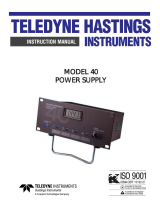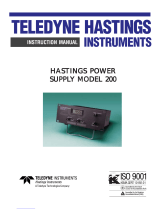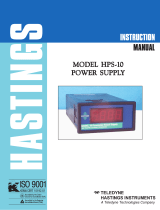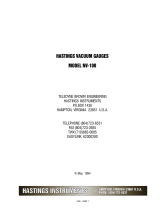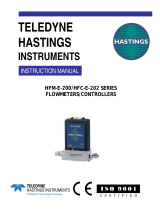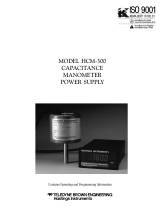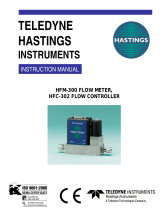Page is loading ...

INSTRUCTION MANUAL
MODEL NALL
MASS FLOWMETERS
TELEDYNE
HASTINGS
INSTRUMENTS
ISO 9001
CERTIFIED

Manual 111-082010_Nall Mass Flowmeters Page 2 of 23
Manual Print History
The print history shown below lists the printing dates of all revisions and addenda created for this manual.
The revision level letter increases alphabetically as the manual undergoes subsequent updates. Addenda,
which are released between revisions, contain important change information that the user should incorporate
immediately into the manual. Addenda are numbered sequentially. When a new revision is created, all
addenda associated with the previous revision of the manual are incorporated into the new revision of the
manual. Each new revision includes a revised copy of this print history page.
Revision A (Document Number 111-041990) ................................................................... April 1990
Revision B (Document Number 111-102003)............................................................... October 2003
Revision C (Document Number 111-082005) ................................................................ August 2005
Revision D (Document Number 111-022006) ............................................................. February 2006
Revision E (Document Number 111-052007).....................................................................May 2007
Revision F (Document Number 111-082010)................................................................. August 2010
Revision G (Document Number 111-122010) ........................................................... December 2010
Visit www.teledyne-hi.com for WEEE disposal guidance.
Hastings Instruments reserves the right to change or modify the design of its equipment without
any obligation to provide notification of change or intent to change.
The instruments described in this manual are designed for Class 2 installations
in accordance with IAW/IPC standards
CAUTION:
CAUTION:
The ins truments described in this manual are designed for INDOOR use only.
The instruments described in this manual are available with multiple pin-outs.
Ensure that all electrical connections are correct.
CAUTION:

Manual 111-082010_Nall Mass Flowmeters Page 3 of 23
Table of Contents
1.0
GENERAL INFORMATION.......................................................................................................................................5
1.1 FEATURES:................................................................................................................................................................... 5
2.0 OPERATING PRINCIPLE ..........................................................................................................................................6
2.1 OPERATING PRINCIPLE.................................................................................................................................................6
3.0 RECEIVING AND INSPECTION...............................................................................................................................7
3.1 INITIAL INSPECTION:....................................................................................................................................................7
3.2 PACKING LIST:.............................................................................................................................................................7
3.3 DECIMAL POINT SETTING: ........................................................................................................................................... 7
3.4 POWER SOURCE:..........................................................................................................................................................7
3.5 ELECTRICAL ZERO:......................................................................................................................................................7
3.6 INDICATION OF FLOW: .................................................................................................................................................7
4.0 INSTALLATION INSTRUCTIONS............................................................................................................................8
4.1 TRANSDUCER..........................................................................................................................................................8
4.2 FILTERS:....................................................................................................................................................................9
4.3 CABLES.....................................................................................................................................................................9
4.4 POWER SUPPLY:...................................................................................................................................................... 9
5.0 USING THE FLOWMETER......................................................................................................................................11
5.1 WARM-UP TIME: .......................................................................................................................................................11
5.2 RESPONSE TIME:........................................................................................................................................................11
5.3 MASS FLOW UNITS:...................................................................................................................................................11
5.4 SPECIAL FACTORY CALIBRATIONS: ........................................................................................................................... 11
5.5 GAS CONVERSION FACTORS:.....................................................................................................................................11
5.6 OUTPUT SIGNAL: .......................................................................................................................................................12
5.7 ACCURACY:...............................................................................................................................................................13
5.8 REPEATABILITY:........................................................................................................................................................ 13
5.9 OVER-RANGE:............................................................................................................................................................ 13
6.0 PRESSURE EFFECTS................................................................................................................................................14
6.1 STANDARD TRANSDUCERS: .......................................................................................................................................14
6.2 LOW PRESSURE DROP TRANSDUCERS:.......................................................................................................................14
6.3 HIGH PRESSURE TRANSDUCERS (OPTIONAL):............................................................................................................ 14
7.0 TEMPERATURE EFFECTS......................................................................................................................................15
7.1 AMBIENT TEMPERATURES:........................................................................................................................................15
7.2 GAS TEMPERATURE ...................................................................................................................................................15
8.0 DIFFERENTIAL PRESSURE....................................................................................................................................16
8.1 TYPICAL PRESSURE DROPS................................................................................................................................ 16
8.2 CHANGES IN DP WITH CHANGES IN LINE PRESSURE...................................................................................16
8.3 DP INCREASE DUE TO FOULING OF THE TRANSDUCER: ............................................................................................. 17
9.0 CALIBRATION...........................................................................................................................................................18
9.1 CALIBRATION PROCEDURES.............................................................................................................................18
10.0 MAINTENANCE.........................................................................................................................................................20
10.1 TRANSDUCERS:..........................................................................................................................................................20
10.2 POWER SUPPLY:.........................................................................................................................................................20
11.0 ACCESSORIES...........................................................................................................................................................21
11.1 OPTIONS AND ACCESSORIES.............................................................................................................................21
11.2 DOUBLE POINT RELAY FLOWMETER/ALARM (DNALL-P):....................................................................................... 21
11.3 TOTALIZERS (TNALL-P):..........................................................................................................................................21
11.4 CHASSIS MODEL (NALL-C):.....................................................................................................................................22
11.5 CURRENT CONVERTER (NALL-P/CC):.......................................................................................................................22

Manual 111-082010_Nall Mass Flowmeters Page 4 of 23
11.6 SPECIFICATIONS................................................................................................... ERROR! BOOKMARK NOT DEFINED.
12.0 WARRANTY AND REPAIR......................................................................................................................................23
12.1 WARRANTY REPAIR POLICY......................................................................................................................................23
12.2 NON-WARRANTY REPAIR POLICY .............................................................................................................................23

Manual 111-082010_Nall Mass Flowmeters Page 5 of 23
1.0 General Information
1.1 Features:
Hastings Linear Mass Flowmeters are designed to accurately measure mass flow without corrections or
compensations for gas pressure and temperature. Due to a linear electrical output signal, the flowmeters are
ideal for use with totalizers and recorders. Hastings Linear Mass Flowmeters do not require any periodic
maintenance under normal operating conditions with clean gases. No damage will occur from the use of
moderate overpressures, overflows, or liquid solvents.
The standard flowmeter calibration is for air. Special calibrations for most other gases such as oxygen,
nitrogen, hydrogen, and carbon monoxide, are available on special order, or by use of a gas multiplier.
Special calibrations are noted by the following options such as OPT-G (special gas) or OPT-R (special
range) and OPT-GR (special gas and range).
Standard HS-Series transducer and L-Series laminar flow elements are available with 300 Series stainless
steel or monel construction. U-Series low pressure drop transducers are constructed of monel.
The basic flowmeter is available in either a cabinet model or a NIM panel. The NIM model can be mounted
side by side in groups of three, in an optional NIM frame. Chassis models are available on special order.

Manual 111-082010_Nall Mass Flowmeters Page 6 of 23
2.0 OPERATING PRINCIPLE
2.1 Operating Principle
Hastings Linear Mass Flowmeters operate
on a unique electrical principle whereby a
capillary tube is heated uniformly by a
transformer. The temperature distribution
is symmetrical about the midpoint at zero
flow (see Figure 2.1) and external
thermocouples TC-1 and TC-2 develop
equal and opposing outputs.
When flow occurs through the tubing,
heat is transferred to the gas and back
again creating an asymmetrical
temperature distribution. For a constant
power input, the differential thermocouple
output is a function of the mass flow rate
and heat capacity of the gas. Since the
heat capacity is relatively constant over
wide ranges of temperature and pressure,
the flowmeter may be calibrated directly
in mass units for any given gas. Changes
in gas composition only require simple
multiplier applied to the air calibration
(see table, page 19) to account for the
difference in heat capacity, thus the
flowmeter is capable of measuring a wide
variety of gases.
High ranges of flow are achieved by
dividing the flow with a fixed ratio
shunting arrangement, as is illustrated in
Figure 2.2. By placing the measuring
tube in parallel with one or more
dimensionally similar channels (laminar
flow elements), viscous restrictions are
created. Therefore, the sensor need heat
only a small portion of the total gas which
results in low power requirements while
retaining mass measuring characteristics.
Fig 2.1
Fig 2.2

Manual 111-082010_Nall Mass Flowmeters Page 7 of 23
3.0 RECEIVING AND INSPECTION
3.1 Initial Inspection:
Carefully unpack the Hastings Linear Mass Flowmeter and inspect it for any obvious signs of damage due to
shipment. Immediately advise the carrier who delivered the shipment of any suspected damage.
3.2 Packing List:
The basic flowmeter consist of four separate parts:
1. The power supply (NALL, NALL-P, NALL-P/CC, DNALL-P, TNALL-P, NALL-C, etc.)
2. The transducer (examples: HS-10S, HS-50KM, etc.)
3. The connecting cable (examples: NF-8-NM, NF-25-NM, etc.)
4. The laminar flow element attached to transducer, for ranges higher than 0-100 SLPM (examples: L-5S,
L-100SF, L-200MF, etc.)
Optional equipment or accessories will be listed as part of the model number or listed separately on the
packing list. (See Section 11.0, OPTIONS AND ACCESSORIES.)
3.3 Decimal Point Setting:
The digital flowmeter has a 3-digit LED display. The decimal point is set as shown in the table below:
3.4 Power Source:
Connect the power supply to 115 volt (10%) 50-60 Hz line. (The prefix “E” indicates the power supply is to
be connected to a 230 volt (10%) 50-60 Hz line.) Connect the power supply to the transducer by means of
the connecting cable. When the flowmeter is turned on the readout may fluctuate somewhat, before settling
to a steady indication.
3.5 Electrical Zero:
After allowing a warm-up time of approximately 30 minutes, close off the INLET and OUTLET
connections on the transducer with the protective plastics end caps shipped on the transducer. If the meter
does not indicate zero flow, adjust the “ZERO” potentiometer located on the front panel, until the meter
indicates zero.
3.6 Indication of Flow:
Remove the end plug or end cap from each end of the transducer and blow air into the inlet side. (The
meter readout should increase indicating the flowmeter is in good working order and ready for installation.)

Manual 111-082010_Nall Mass Flowmeters Page 8 of 23
4.0 INSTALLATION INSTRUCTIONS.
4.1 TRANSDUCER
4.1.1 Orientation of the Transducer
The transducer may be mounted in any position, as long as the direction of gas flow through the transducer
is from “IN” to “OUT” as marked on the transducer base. (U-Series transducers should be mounted in a
horizontal position only.)
4.1.2 Mounting the Transducer
There are two ¼-20 threaded holes 3/8” deep in the bottom of the transducer that can be used to secure it to
a mounting bracket, if desired. When the transducer is used in combination with an L or LU Series Laminar
Flow Element (LFE), the LFE should be supported instead of the transducer to prevent undue strain on the
connectors between the transducer and the LFE. Standard pipe support rings or pipe hangers are usually
satisfactory for supporting the LFE.
4.1.3 Inlet and Outlet Connections
The table 4.1 describes the inlet and outlet connections for all standard transducers. (If it is necessary to
reduce the pipe size or install an elbow on either side of an L or LU Series Laminar Flow Element, it is
recommended that a straight pipe 12” in length, and of pipe or flange size stated below, be connected
directly to the LFE before connecting a smaller diameter pipe or an elbow.)
4.1.4 Sealing the Threaded Connections
Many users find that Teflon tape is an excellent sealant for most applications, however, any sealant material
compatible with the flow system is acceptable. Caution must be exercised during assembly and disassembly
of the threaded connections to prevent shreds of the Teflon tape, or the sealant from entering the flow line,
where they could block the small passages in the transducer.

Manual 111-082010_Nall Mass Flowmeters Page 9 of 23
The use of O-ring seal connectors on the transducers with female threads is often more convenient for many
low pressure applications, such as with U-Series transducers.
4.1.5 Checking for Leaks
Check the transducer connections for leaks by pressurizing the line to the operating pressure (not to exceed
250 psig except on high pressure models), and applying a diluted soap solution to the pipe joints. Any gas
escaping from the pipe joints will cause a continuous stream of bubbles.
4.2 FILTERS:
If the flow stream carries particles large enough to block the small passages inside the transducer
(approximately .02” ID) a filter should be installed in the flow line of the inlet side of the transducer.
4.3 CABLES
4.3.1 Description
A standard 5-conductor 20 gauge shielded 8-foot long cable (NF-8-NM) is normally ordered with each
flowmeter and is used for connecting the power and the transducer. Longer cables are available upon special
request.
4.3.2 Cable Length
The cable length can be extended to 25 feet without changing the calibration of the flowmeter by more than
SP+/-1% of the rated full scale flow. Cables longer than 25 feet will cause the indicated flow rate to be lower
than the actual flow rate and recalibration may be required. (See Section 7.0 for calibration procedures.)
4.3.3 Cable Conductor Size
In the event cable conductors larger than #20 are desired, the connecting cable can be extended to greater
lengths without having to recalibrate the flowmeter. The table below shows the relationship of the conductor
size to the maximum cable length that can be used without changing the calibration by more than 1% of full
scale.
4.4 POWER SUPPLY:
4.4.1 Mounting
One type of housing available for the power supply is a small metal cabinet, 7.75” X 5.75”X 5.75”, which
can sit on a table or desk or can be mounted securely on a bracket. The “NIM” style package is 5.41” X
8.71” X 9.68”, and can be housed in an 8.75” X 19.00” relay rack-panel.
4.4.2 Electrical Connections
Connect the power supply to the transducer with the NF-8-NM connecting cable (Section 4.3) and connect
the AC line cord to a suitable power source (Section 3.4).

Manual 111-082010_Nall Mass Flowmeters Page 10 of 23
4.4.3 Electrical Zero Check
Turn the power supply “ON” and allow the flowmeter 30 minutes to warm up. Stop all flow through the
transducer and check the electrical zero.
CAUTION: DO NOT ASSUME THAT ALL METERING VALVES WILL COMPLETELY
SHUT OFF FLOW. EVEN A SLIGHT LEAKAGE THROUGH A VALVE WILL CAUSE AN
INDICATION ON THE METER WHICH WILL FALSELY APPEAR TO BE A ZERO SHIFT.
If necessary, adjust the “ZERO” potentiometer located on the front panel of the power supply, until the
meter indicates zero.

Manual 111-082010_Nall Mass Flowmeters Page 11 of 23
5.0 USING THE FLOWMETER
USING THE HASTINGS LINEAR MASS FLOWMETER
5.1 Warm-Up Time:
When the flowmeter is first turned on, the meter will fluctuate somewhat before settling to a stable
indication. The flowmeter indicates the mass flow to +/- 3% of full scale in about 5 minutes, but should be
allowed to warm up for 30 minutes to achieve maximum accuracy.
5.2 Response Time:
The response time to a change in flow is logarithmic and is approximately 7 seconds for a 67% change and
30 seconds for a 90% change. Pneumatic imbalance in the associated plumbing will often cause the response
time to appear longer due to additional time required for flow to stabilize in the system. If a faster response
time is desired, consult the factory.
5.3 Mass Flow Units:
The units of mass flow used with the Models NALL, ENALL, NALL-P, and ENALL-P mass flowmeters are
the “standard cubic centimeter per minute” (SCCM) and/or the “standard litre per minute” (SLPM). An
SCCM is the volume occupied by a given mass of gas at a specified temperature and pressure referred to as
standard conditions (STP). These conditions are defined as 0° C (32°F) and 760 Torr (14.7 psia). A one
litre volume of gas is equivalent to 1000 cm³ of the same gas. Those models incorporating a Laminar Flow
Element (LFE) use “standard cubic foot per minute” (SCFM) units, which are equivalent to a flow of
28,300 SCCM or 28.3 SLPM. To convert to other units of mass flow, multiply the mass flow rate of the gas
by the density of the gas at standard conditions.
Example: What is the equivalent mass flow in grams per minute of 100 SCCM of air?
Solution: The density of air at 0° C and 760mm of Hg is .00129 gm/cm³.
Mass Flow = 100 SCCM X .00129 gm/cm³.
= .129 gm/min.
5.4 Special Factory Calibrations:
All Hastings Mass Flowmeters are calibrated for air unless otherwise specified. Calibrations for a special
range or for a gas other than air are clearly indicated on the front panel readout of standard models, or by
special comments or curves in the manual. Calibrations traceable to the National Institute of Standards &
Technology (NIST), can also be made for an extra charge.
5.5 Gas Conversion Factors:
The Hastings Linear Mass Flowmeter can be used for many different gases as long as the gas is compatible
with materials of construction. No electrical adjustments are necessary when using the gas conversion factors
so the original calibration is undisturbed.
5.5.1 Flowmeters Factory Calibration for Air
A flowmeter originally calibrated for air can measure other gases by using the Hastings Gas Conversion
Factors on Page 35 of this manual. Simply multiply the meter indication by the appropriate gas conversion
factor (K).
Example: What is the actual flow rate of Helium through a flowmeter calibrated for Air if the
meter reading is 50 SCCM?
Solution: From the table on page 35, the gas conversion factor for Helium is 1.382.

Manual 111-082010_Nall Mass Flowmeters Page 12 of 23
Actual flow = meter reading X (KHe)
= 50 SCCM X 1.382
= 69.1 SCCM of Helium
5.5.2 Flowmeter Factory Calibrated for a Special Gas
If the Hastings Linear Mass Flowmeter is calibrated for a gas other than air, it may also be used to measure
the flow rate of many other gases. The flow rate will be equal to the meter reading multiplied by the ratio of
the gas conversion factors.
Example: What is the actual flow rate of Carbon Dioxide through a flowmeter calibrated for Helium, if
the meter reading is 96 SCCM?
Solution: Flow of CO2‚ = (meter reading) (K for CO2)
K for He
= (96 SCCM) * .6933
1.3820
= 48.2 SCCM
5.5.3 Gas Mixtures
If a mixture of gases is used and the percentage by volume of each gas is reasonable constant, a conversion
factor for the gas mixture can be obtained.
K (mix) = _____________________________1__________________
__ __ __
Va + Vb + Vc + ….
Ka Kb Kc
Where
V (a, b, ….) = percent of gas a, b ….)
K = conversion factor
K can be obtained from the table beginning on page 35 for many gases.
Example: What is the conversion factor for a mixture of 20% Hydrogen, 40% Argon, and 40%
Oxygen?
Solution: = _________________________1______________
__ __ __
Va + Vb + Vc + ….
Ka Kb Kc
=__________________________1______________
.2 + .4 + .4
1.01 1.41 .96
= 1.11
5.6 Output Signal:
The two output terminals on the back of the power supply provide a 0-5 VDC signal for recording or
operating auxiliary equipment such as flow controllers or converters. The output signal is linear with respect
to mass flow and has sensitivity equal to the rated full-scale flow rate divided by 5.00 VDC.

Manual 111-082010_Nall Mass Flowmeters Page 13 of 23
Example: (A) What is the output sensitivity of HS-1KS?
(B) What is the flow rate for a 2.71 volt output?
Solution: (A) Sensitivity = rated flow
Rated output
= 1000 SCCM
5.00 VDC
= 200 SCCM/VDC
(B) Mass Flow = output X sensitivity
= 2.71v X 200 SCCM/VDC
= 542 SCCM
5.7 Accuracy:
The accuracy of the flow indication is +/- 1% of full scale, with the exception of the U-Series transducer
where the accuracy is +/- 3% of full scale.
5.8 Repeatability:
The repeatability over a six-month period is +/- ½% of full scale if the flowmeter is operating normally in a
clean, dry system. Under reasonable constant conditions, a repeatability of +/- 1 to +/- 2% of
INDICATION can be expected on a day-to-day basis.
5.9 Over-range:
The flowmeter has an output signal which is directly proportional to mass flow and linear to +/- of full scale
from zero flow to the normal full-scale flow rate.
The flowmeter can be used to measure flow rates higher than the rated maximum flow, but the output signal
normally becomes non-linear above 5 volts d-c. A calibration curve for voltage vs. flow can be made for
outputs up to 10 volts d-c. At some point above 10 volts d-c the output will no longer increase as the flow
increases. The flow rate required to produce this condition is several times the normal full-scale flow rate.
Once flow is reduced to the proper level, the flow meter will again indicate mass flow currectly. The
flowmeter will not be damaged by excessive flow rates as long as the pressure in the line does not exceed the
pressure rating for the transducer.

Manual 111-082010_Nall Mass Flowmeters Page 14 of 23
6.0 PRESSURE EFFECTS
6.1 Standard Transducers:
The Hastings Linear Mass Flowmeter can measure mass flow accurately without corrections for a variation
in line pressure from one psia (.068 ATM) to 250 psig (18 ATMS.) Mass flow indications are possible with
downstream pressures as low as .03 psia (.002 ATM), but the upstream must be much higher because of the
increase in pressure drop across the transducer (see Section 8.0).
6.2 Low Pressure Drop Transducers:
The low pressure drop Mass Flowmeter (using U-Series transducers) can measure flow accurately from .03
psia ( .002 ATM) to 15 psig ( 2 ATMS). The transducer is rated for a maximum pressure of 250 psig ( 18
ATMS). Mass flow indications are possible with downstream pressure as low as .1 Torr with upstream
pressures of less than 30 Torr. This flowmeter has been successful for many years in measuring uranium
hexafluoride flow rate under vacuum conditions, and has also been useful in measuring vacuum pumping
speeds and in atmospheric sampling trains.
6.3 High Pressure Transducers (Optional):
Hastings transducers having a P suffix have been pressure tested to 1500 psig using dry nitrogen gas. The
transducer was cycled between 0 and 1500 psig for two periods with a minimum of 5 minutes each, and held
at the pressure for a combined test period of 10 minutes. It was then leak tested on a Helium Leak Detector
where a leak rate of no more than 3 X 10-6 SCCS was required.
The flowmeter has been designed and tested as described above for line pressure up to 1500 psig under
normal usage. High pressure gas is always potentially dangerous and we strongly urge that extreme caution
be taken in locating, installing, and operating this equipment.

Manual 111-082010_Nall Mass Flowmeters Page 15 of 23
7.0 TEMPERATURE EFFECTS
7.1 Ambient Temperatures:
7.1.1 Transducer
In order to maintain the accuracy of the flowmeter with changes in ambient temperature, it is necessary to
keep the temperature of the transducer between 10° C and 50° C. (The temperature of the base is normally
about 10° C above ambient due to internal heat.) There are two ¼”-20 bolt holes in the bottom of the
transducer to facilitate mounting the transducer to an external heat sink. Since some of the temperature shift
results in a slight zero offset, better results are obtained if the flowmeter is re-zeroed at the operating
temperature.
7.1.2 Power Supply
The NALL-type power supply can be operated over an ambient temperature range of 0° C to 40° C without
causing a calibration shift of more than +/- 1% of full scale. Since this error is primarily a zero shift, it can be
eliminated by adjusting the flowmeter ZERO potentiometer at the given operating temperature.
7.2 Gas Temperature
No corrections for gas temperature between 0° C and 100° C are necessary for the small ranges, but some
correction may be necessary for higher ranges. Part of the error at high ranges is transitory, and in most
cases will be reduced when the transducer temperature and gas temperature reach an equilibrium condition.
Gas flow at temperatures between -50°C and + 200° C can often be measured, but require recalibration by
the customer at operating conditions. Consult the factory for further details.
When using the NALL – or NALL –P Series flowmeter with a Laminar Flow Element, it is recommended
that both the Laminar Flow Element and the HS-10S (or HS-10M) transducer operate at the same
temperature.
The Hastings Linear Mass flowmeter measures GAS flow. DO NOT let the temperature and/or pressure of
the gas reach a point that would cause the gas to change to a liquid state, or erroneous indications will result.

Manual 111-082010_Nall Mass Flowmeters Page 16 of 23
8.0 DIFFERENTIAL PRESSURE
8.1 TYPICAL PRESSURE DROPS
The differential pressure drop (DP) across the Hastings HS-Series Mass Flow Transducer can vary between
0.50” H2O depending upon the transducer’s range. Other pressure drops are listed below and all are based
upon full-scale flow rates of air at 0°C and 760 Torr.
8.2 CHANGES IN DP WITH CHANGES IN LINE PRESSURE
The typical differential pressure drops listed in the table above are for operation at atmospheric pressure. As
the line pressure changes, the differential pressure drop for the same flow rate will also change.
8.2.1 Increase in Line Pressure
The differential pressure drop across the transducer will decrease proportionately as the absolute line
pressure increases as stated in the following equation:
DP = DP (@STP) Pressure (STD)
Pressure (ACT)
Where DP = Transducer differential pressure at 0oC and 760 Torr
Pressure (STD) = 14.7 psia
Pressure (ACT) = 14.7 psia + line pressure

Manual 111-082010_Nall Mass Flowmeters Page 17 of 23
8.2.2 Decrease in Line Pressure
The relationship stated in Section 8.2.1 also shows that DP increases proportionally as absolute line pressure
decreases. This situation is true until the DP becomes a significant part of the total absolute line pressure.
When this occurs, the relationship becomes more complex but the effect is still the same. The change in DP
does not affect the accuracy of the mass flow indications, but causes a change in the minimum upstream
pressure necessary to force a given amount of flow through the transducer.
8.3 DP Increase Due to Fouling of the Transducer:
A DP measurement across the transducer can often provide a good indication of fouling inside the
transducer. The values given in the Table on the preceding page are typical and may vary as much as 50%
for any given model. However, an increase in DP of two or three times the typical value is definitely an
indication of fouling. When checking for changes in DP, the flowmeter should be in operation at or near
standard conditions of 0oC and 760 Torr in order to relate the measured DP to those listed in the
Table. If there is an indication of fouling, refer to Section 10.1.

Manual 111-082010_Nall Mass Flowmeters Page 18 of 23
9.0 Calibration
9.1 CALIBRATION PROCEDURES
The Hastings Mass Flowmeter has been carefully inspected and calibrated at the factory before shipment and
will give long, reliable service. Calibration is stable, and recalibration is seldom necessary under normal
operating conditions; however, to maintain optimum accuracy it is advisable to check calibration on an
annual basis. The unit may be returned to the factory for this purpose, but if that is undesirable, the
following calibration procedure may be of assistance:
1. Connect the power supply to the proper power source (Section 3.4).
2. Turn the power supply “ON” and allow 30 minutes for warm-up.
3. Set the “electrical zero” (Section 3.5).
4. Connect the inlet side of the transducer through a metering valve, to a well-regulated air source and the
outlet to a reliable flow reference such as the Hastings Mini-Flo Calibrator.
5. Check transducer heating voltage as outlined in Section 10.2.1.
6. During normal calibration, a flowmeter is spanned at 80% of full scale to obtain best average linearity.
Example: A 50 SCCM flowmeter with 0-5 VDC output at the binding posts is to be calibrated. If a
reference flow standard is set at a 40 SCCM flow rate, the flowmeter should indicate 80% (.80 X 50 SCCM
= 40 SCCM) of full scale. At this flow rate, the voltage at the binding posts should read 4 VDC (80% X 5
VDC).
CAUTION: Most flow standards are volumetric devices and must be corrected for temperature and
pressure to standard conditions of 0oC and 760 Torr. This correction amounts to several percent at normal
room temperatures and pressures and should not be neglected.
7. If the flowmeter does not agree with the reference flow standard, it is first necessary to correct the output
at the binding posts. This is done by making a small adjustment to the “GAIN” potentiometer R-30,
located on the circuit board inside the power supply. This adjustment will also produce a change in the
meter indication.
8. If the meter reading (flow) does not correspond with the binding post’s output (voltage), make a small
adjustment to the “METER” trim potentiometer R-32, located on the circuit board inside the power
supply. This correction has no effect on the output voltage.
9. PC-581A Board Only: Refer to Figure 9.1. Do not change the dipswitch (S2) settings. These settings
are factory pre-set and should only need changing if there is a change in the transducer or the units of
calibration. Switches 1, 2, & 3 change gain and 5, 6, 7, & 8 change the meter range to engineering units.
The number 4 position should remain closed.

Manual 111-082010_Nall Mass Flowmeters Page 19 of 23
TRANSDUCER
MILLIVOLT
TEST
+5 VDC OUTPUT
BIAS METER GAIN TRMS AC TEST
JUMPER T1
FOR 230V OPERATION
FOR 581A ONLY FIG 9.1

Manual 111-082010_Nall Mass Flowmeters Page 20 of 23
10.0 Maintenance
10.1 Transducers:
10.1.1 Cleaning
With proper care in installing and use, the transducer will require little or no maintenance. Should the small
passages in the transducer become partially clogged, they can be cleaned with any suitable solvent such as
acetone, vythene, etc. and/or blown out with clean air under moderate pressure (up to 50 psig).
NOTE: If solvents are used for cleaning the transducer, sporadic indications may occur when it is returned
to service due to residual moisture in the passages of the transducer. Time should be allowed for the liquid
solvent to evaporate.
10.1.2 Damage to the Transducer
The transducer can be checked for internal electrical damage by disconnecting the cable and using an ohm-
meter to measure resistances at the 6-pin connector. Internal repairs to the transducer are not recommended
and should only be done at the factory. Attempting to remove the transducer cover or the nut on the
connector may result in irreparable damage to the transducer. The table below is for determining whether or
not some damage has occurred and IS NOT to be used as a guide for repairs.
10.2 Power Supply:
NALL and NALL-P power supplies are very stable and should require little or no maintenance. An
occasional check of the electrical zero is recommended but drift will be small under normal operating
conditions.
10.2.1 Power Supply Troubleshooting
If a problem does occur, the transducer heating voltage and the transducer output can be checked (refer to
Figure 9.1). To check the heating voltage, the flowmeter must be connected to the transducer and a true
R.M.S. voltmeter must be used. With the TRMS voltmeter connected between test points D and A (TRMS
AC test), the voltage should be 16.00 TRMS VAC +/- 0.1 VAC (and can be adjusted by the BIAS pot, R6).
The transducer output is measured between test points BC and E (millivolt test) using a DC millivolt meter.
This output will vary as flow through the transducer varies. At full scale flow for the transducer, the millivolt
meter should read between 0.75 and 7 millivolts DC, depending on the individual transducer. This signal is
amplified to produce the flowmeter output.
If it is necessary to return the flowmeter for repair, please return the transducer, power supply, and cable to
Teledyne Hastings-Raydist with a detailed explanation of the problem. Use the Service Repair form on page
35. This will help to ensure prompt, reliable service.
/
